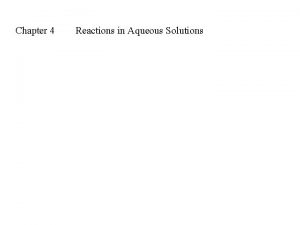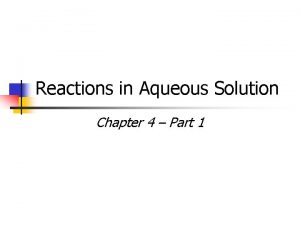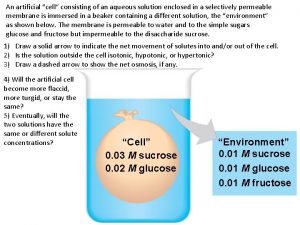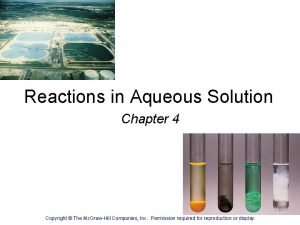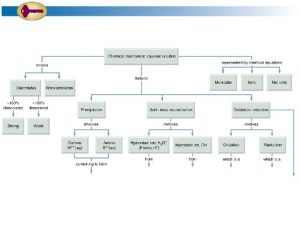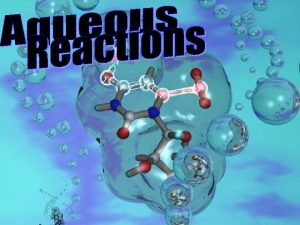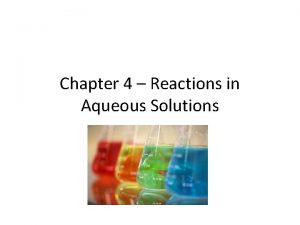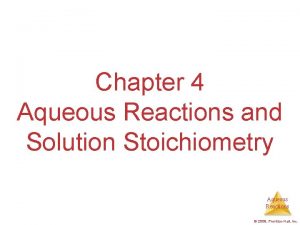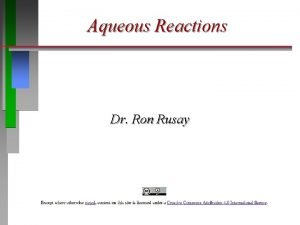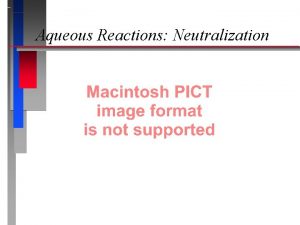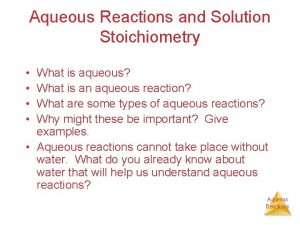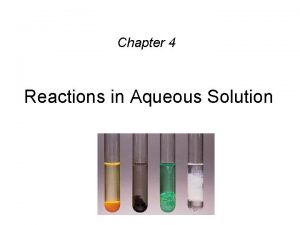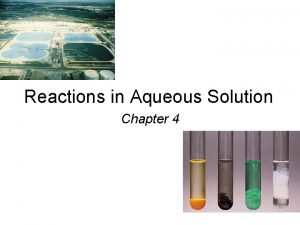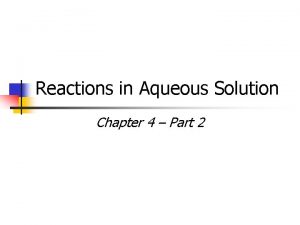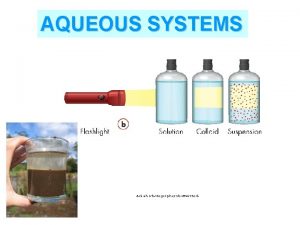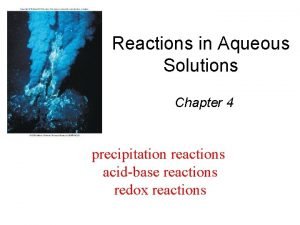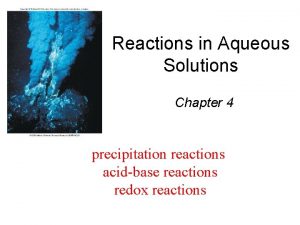Reactions in Aqueous Solution Chapter 4 Part 3





















- Slides: 21

Reactions in Aqueous Solution Chapter 4 – Part 3

Acid Base Reactions Proton Transfer Reactions AKA - Neutralization

Acids: n n Substances that increase the concentration of H+ when dissolved in water (Arrhenius). Proton donors (Brønsted–Lowry).

Acids There are only seven strong acids:

Monoprotic acids HCl H+ + Cl- HNO 3 CH 3 COOH H+ + NO 3 H+ + CH 3 COO- Strong electrolyte, strong acid Weak electrolyte, weak acid 4. 3

Diprotic acids H 2 SO 4 H+ + HSO 4 - Strong electrolyte, strong acid HSO 4 - H+ + SO 42 - Weak electrolyte, weak acid Triprotic acids H 3 PO 4 H 2 PO 4 HPO 42 - H+ + H 2 PO 4 H+ + HPO 42 H+ + PO 43 - Weak electrolyte, weak acid 4. 3

Bases: n n Substances that increase the concentration of OH− when dissolved in water (Arrhenius). Proton acceptors (Brønsted–Lowry).

Bases The strong bases are the soluble salts of hydroxide ion:

Neutralization Reactions Generally, when solutions of an acid and a base are combined, the products are a salt and water. HCl (aq) + Na. OH (aq) Na. Cl (aq) + H 2 O (l) Salts are less reactive than acids and bases. Why do they do that?

Neutralization Reactions When a strong acid reacts with a strong base, the net ionic equation is… HCl (aq) + Na. OH (aq) Na. Cl (aq) + H 2 O (l)

Gas-Forming Reactions n Sometimes the expected product predicted by just switching the ion partners decomposes to give a gaseous product (CO 2 or SO 2). Ca. CO 3 (s) + HCl(aq) Ca. Cl 2(aq) + CO 2(g) + H 2 O (l) Na. HCO 3(aq) + HBr(aq) Na. Br(aq) + CO 2(g) + H 2 O(l) Sr. SO 3(s) + 2 HI(aq) Sr. I 2(aq) + SO 2(g) + H 2 O(l) Why do they do that?

Gas-Forming Reactions n n This reaction gives the predicted product, but you had better carry it out in the hood, or you will be very unpopular! Just as in the previous examples, a gas is formed as a product of this reaction: Na 2 S (aq) + H 2 SO 4 (aq) Na 2 SO 4 (aq) + H 2 S (g)

Solution Stoichiometry Count with Volume!

Molarity n n Two solutions can contain the same compounds but be quite different because the proportions of those compounds are different. Molarity is one way to measure the concentration of a solution. moles of solute Molarity (M) = volume of solution in liters

4. 5

Making Solutions M = molarity = moles of solute liters of solution What mass of KI is required to make 500. m. L of a 2. 80 M KI solution? 4. 5

Dilution is the procedure for preparing a less concentrated solution from a more concentrated solution. Dilution Add Solvent Moles of solute before dilution (i) = Moles of solute after dilution (f) Mi V i = Mf V f 4. 5

How would you prepare 60. 0 m. L of 0. 200 M HNO 3 from a stock solution of 4. 00 M HNO 3? 4. 5

Using Molarities in Stoichiometric Calculations

Titration The analytical technique in which one can calculate the concentration of a solute in a solution.

What volume of a 1. 420 M Na. OH solution is Required to titrate 25. 00 m. L of a 4. 50 M H 2 SO 4 solution? 4. 7
 Types of reactions
Types of reactions Aqueous reactions and solution stoichiometry
Aqueous reactions and solution stoichiometry Chapter 4 reactions in aqueous solutions
Chapter 4 reactions in aqueous solutions Concentrated solution
Concentrated solution Chapter 4 reactions in aqueous solutions worksheet answers
Chapter 4 reactions in aqueous solutions worksheet answers Which solution
Which solution Reactions in aqueous solutions
Reactions in aqueous solutions Aqueous solution
Aqueous solution An artificial cell consisting of an aqueous solution
An artificial cell consisting of an aqueous solution What is aqueous
What is aqueous Paint dosage form
Paint dosage form Assume that an aqueous solution of a cation
Assume that an aqueous solution of a cation Chemical reactions section 2 classifying chemical reactions
Chemical reactions section 2 classifying chemical reactions How to write a balanced redox reaction
How to write a balanced redox reaction Section 2 classifying chemical reactions
Section 2 classifying chemical reactions Unit 5 chemical reactions answers
Unit 5 chemical reactions answers Reactions that produce gas
Reactions that produce gas The cell reaction for the zn-h2 cell is
The cell reaction for the zn-h2 cell is Types of chemical reactions and solution stoichiometry
Types of chemical reactions and solution stoichiometry Types of chemical reactions and solution stoichiometry
Types of chemical reactions and solution stoichiometry Modern chemistry chapter 13
Modern chemistry chapter 13 Tyndall effect
Tyndall effect


